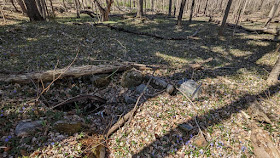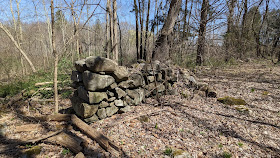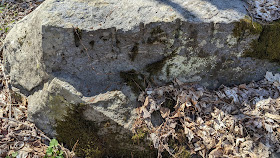Pages
Monday, April 24, 2023
Wednesday, April 19, 2023
Here on the Ground
Here on the
ground, on this Nonnewaug landscape,
The zig zag "stone walls" are anything but
Tossed stones where a wooden worm fence used to be...
I’d show you
this Stone Serpent, guarding the roadway,
Protecting the enclosure closest to the west bank
of the Nonnewaug Fish Weir,
But it was crushed and buried
by a partially federally funded town road realignment in 2007…
Those “Stone
Walls” aren’t so simple as you may have been told,
In
conjecture after conjecture based on older conjecture of
Yankee
Farmers flinging stones up against the snake rails
– or under those cross and rails -
But here on
the ground, on the Nonnewaug landscape,
The Great Serpents
keep watch where they still can,
Where they
haven’t been bulldozed or buried or plundered.
Guarding
against Thunderbird fires
–
or Grandmother’s fires around the blueberries –
Grandfather’s
fire to drive the deer,
Sometimes by
clearing the roadway
Or perhaps renewing the forest and the upland high places…
“Land documents show that the most freely shared lands are termed cotinakeesh or, alternately, cotinakeel ([kuttinakíś/akíl] ILDHC 1923:folios 84–86). Kuttinakíś derives from the Nipmeuw word kuttahham, given as “he digs (it)/he plants” (Trumbull 1903:84; probably “you and 2nd person plant;” viz. kutkihcámun, “you and I plant” [Mohegan Tribe 2004:56]), and aku, “land.” Kuttinakíś refers, then, to the planting lands—lands that lie mostly in the main floodplain and in alluvial areas along creeks in the uplands. These kuttinakíś the survivors of the genocide readily leased because, tragically, the massacres had left the fields unused. Secondarily, keesh occurs as a pejorative ending, so these may be “lesser/poor” planting lands. The second land type leased rather freely is the village site (otan(ak), “village(s),” otanèmës, “small village” Nipmeuw [Gustafson 2000:28]; viz. otanik, “to the village,” Mahhekanneuw [Miles 2015:14], also Odanak/St. Francis, Québec, “at the village,” Abenaki, ùtane, “village,” Modern Unami Lënapeuw), which places also lay emptied by tragedy (ILDHC 1923:passim). However, upland areas are the subject of restrictions and reserved rights for use by the Nipmuc and Pocumtuck. Reserved rights to hunt, fish, trap, and set up temporary living spaces (as well as to secretly worship) in the upland woods are repeated throughout the land documents for Western Massachusetts…” https://www.academia.edu/44991023/Eli_Luweyok_Kikayunkahke_So_Said_the_Departed_Elders_Northeastern_Algonquian_Land_Use_Traditions
Friday, April 14, 2023
Turned Around by the Park (Middlebury CT)
I had just passed by the park entrance, when a big "stone wall" caught my attention, down below the old turnpike. Quite massive and not far from a parking spot, making it an easy walk on a bright and warm spring day.
So I turned around to take a little look around...
It's obviously an old house site, from the time before the dam was built for flood control after the Great Flood of 1955 - and that's all I really know about it. Except that the blue periwinkle has persisted, growing over the old foundation and retaining walls - and an old car appears to be buried in a certain spot, marked by a piece of chrome that hasn't tarnished very much at all that glistened in the sunlight...
Split-filled Boulders: "A total of 386 sites contained
split-filled boulders. A possible Algonquian term for this type is pindaxsenakan - literally, "a
living being enters into something," on the idea that these were
considered spirit portals to the underworld," Dr. Curtiss Hoffman writes
in “Stone Prayers” (2018).
https://www.arcadiapublishing.com/Products/9781634990493
And I find Nohham writes that a “Skuguisu káhtqwk refers to a "boulder-based cairn" which is possibly an emerging serpent form…”
I did take a photo of the other side:
Thursday, April 13, 2023
Our Hidden Landscapes by Lucianne Lavin and Elaine Thomas
Indigenous Stone Ceremonial Sites in Eastern North America
"Challenging traditional and long-standing understandings, this volume provides an important new lens for interpreting stone structures that had previously been attributed to settler colonialism. Instead, the contributors to this volume argue that these locations are sacred Indigenous sites.
This volume introduces readers to eastern North America’s Indigenous ceremonial stone landscapes (CSLs)—sacred sites whose principal identifying characteristics are built stone structures that cluster within specific physical landscapes. Our Hidden Landscapes presents these often unrecognized sites as significant cultural landscapes in need of protection and preservation.
In this book, Native American authors provide perspectives on the cultural meaning and significance of CSLs and their characteristics, while professional archaeologists and anthropologists provide a variety of approaches for better understanding, protecting, and preserving them. The chapters present overwhelming evidence in the form of oral tradition, historic documentation, ethnographies, and archaeological research that these important sites created and used by Indigenous peoples are deserving of protection.
This work enables archaeologists, historians, conservationists, foresters, and members of the general public to recognize these important ritual sites."
Contributors
Nohham Rolf Cachat-Schilling
Robert DeFosses
James Gage
Mary Gage
Doug Harris
Julia A. King
Lucianne Lavin
Johannes (Jannie) H. N. Loubser
Frederick W. Martin
Norman Muller
Charity Moore Norton
Paul A. Robinson
Laurie W. Rush
Scott M. Strickland
Elaine Thomas
Kathleen Patricia Thrane
Matthew Victor Weiss
Tuesday, April 04, 2023
Silly Yankee Farmer William Nilly in 1740
Silly William Nilly in 1740
Yankee Farmer on a Hill Top
When there’s all those abandoned Indian Villages
Surrounded by already cleared agricultural fields to be
legally acquired
By simply using split wooden rails to “improve” his homelot…
Silly William Nilly in 1740
He built a stone fence,
And a post and rail fence,
And piled his stones, Willy Nilly, on the other side,
Silly William Nilly in 1740...Monday, April 03, 2023
"Serpent Stacked/Serpent Laid" Indigenous Causeway (CT)
"If the courses of stonework are laid down in such a way as to resemble Big Snakes,
Then there is a high degree of probability that it is an Indigenous made feature..."
https://wakinguponturtleisland.blogspot.com/2021/10/culvert-like-causeway-like-paugussett.html
Sunday, April 02, 2023
Almost a "Good Fence" (NY)
Six rails
are said to make a legal worm-fence;
Heavy rocks are often placed- under
the corners
And a fence
built with 1 1/2 to 2 feet of stone,
With 3 rails
above,
Is deemed a Good Fence.



































_-_Dioramas_in_the_Fisher_Museum_(Harvard_Forest)_-_DSC07368.jpg)


.jpg)














